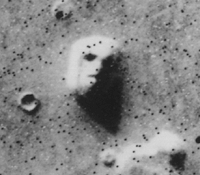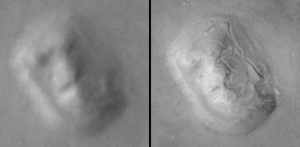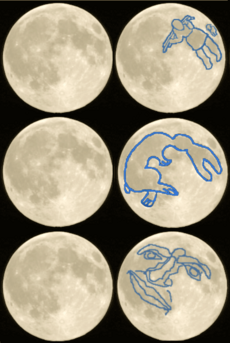Pareidolia facts for kids
Have you ever seen a face in the clouds, a rabbit on the moon, or a smiley face on an electrical outlet? If so, you've experienced pareidolia (pronounced par-eye-DOH-lee-ə). It's when our brain finds a familiar pattern, like a face or an animal, in something that is actually random.
Pareidolia is a very common and normal thing that happens to almost everyone. It's a type of apophenia, which is the brain's tendency to see connections between unrelated things. Pareidolia isn't just about seeing things. It can also happen with sounds, like hearing words in the static from a fan or an air conditioner.
Contents
Why Do Our Brains See Faces Everywhere?
Our brains are like super-detectives, always looking for patterns to make sense of the world. The most important pattern for humans is the face. Being able to recognize faces quickly helped our early ancestors survive. It let them know if someone was a friend, an enemy, or if an animal was watching them.
Because of this, our brains have a special area just for recognizing faces. This part of the brain is so good at its job that it sometimes gets a little carried away. It sees faces in things like rocks, burnt toast, or the front of a car. It's a kind of optical illusion, but it happens inside your brain. Seeing these patterns is a sign that your brain is working correctly, not that you're seeing something that is really there.
Famous Examples of Pareidolia
Pareidolia happens all the time, all around the world. Some examples have become very famous.
In Nature
The Face on Mars
One of the most famous examples of pareidolia is the "Face on Mars." In 1976, a NASA spacecraft took a picture of a region on Mars called Cydonia. One of the rocky hills, called a mesa, looked a lot like a human face staring up into space. For years, some people believed it was a monument built by aliens.
However, years later, newer spacecraft with better cameras took more detailed pictures of the same hill. These new photos showed that the "face" was just a trick of light and shadow on a normal rock formation.
Shapes in Rocks and Clouds
People often see shapes in natural formations on Earth, too. These are sometimes called mimetoliths (meaning "mimic stones").
- The Old Man of the Mountain in New Hampshire, USA, was a famous cliff that looked like the profile of an old man's face. It was a popular tourist attraction until it collapsed in 2003.
- Looking up at the sky, it's common to see shapes of animals, objects, or faces in the clouds. This is a classic example of pareidolia that almost everyone has experienced.
The Man in the Moon
For thousands of years, people from different cultures have seen images on the surface of the full moon. The dark patches on the moon are large, flat plains of ancient lava.
- In many Western cultures, people see the face of the "Man in the Moon."
- In East Asian cultures and some Native American traditions, people see a "Moon rabbit," often pounding rice in a mortar.
In History
The Canals of Mars
In 1877, an Italian astronomer named Giovanni Schiaparelli observed Mars through his telescope. He saw what he described as canali, an Italian word meaning "channels." When this was translated into English as "canals," many people got excited. They thought it meant there were intelligent beings on Mars building waterways.
An American astronomer, Percival Lowell, became very interested and drew detailed maps of hundreds of Martian canals. This led to many science fiction stories about Martians. However, just like the "Face on Mars," better telescopes later showed that there were no canals. The lines were an optical illusion caused by the brain connecting random dark spots on the planet's surface.
In Art and Literature

Some artists have used pareidolia on purpose to make their work more interesting.
- Leonardo da Vinci wrote that artists could find inspiration by looking at a stained wall and seeing landscapes, battles, or strange faces.
- The artist Giuseppe Arcimboldo was famous for painting portraits where the person's face was made up of fruits, vegetables, or books.
Pareidolia also appears in literature. In William Shakespeare's play Hamlet, Prince Hamlet tests a man named Polonius by pointing at a cloud:
- Hamlet:
Do you see yonder cloud that's almost in the shape of a camel?
Polonius:By th'Mass and 'tis, like a camel indeed.
Hamlet:Methinks it is a weasel.
Polonius:It is backed like a weasel.
Hamlet:Or a whale.
Polonius:Very like a whale.
Seeing Famous Figures
Sometimes, people report seeing the faces of religious figures in everyday objects. There have been many cases of people seeing faces in clouds, water stains, tree bark, or even on food.
One famous example was a grilled cheese sandwich made in 2004 that the owner believed had the face of the Virgin Mary on it. The sandwich was sold on eBay for $28,000. These sightings are another example of our brains trying to find familiar patterns in random shapes.
Hearing Things: Auditory Pareidolia
Pareidolia can also happen with sounds. This is when the brain finds a meaningful pattern, like words or music, in random noise.
- You might hear faint music or talking in the hum of a refrigerator or an air conditioner.
- Another example is backmasking, where people claim to hear hidden messages when a song is played backward. Most of the time, these "messages" are just the result of the brain trying to make sense of meaningless sounds.
When Computers See Faces
Humans aren't the only ones who experience pareidolia. Computers with artificial intelligence (AI) can do it too. Computer programs designed to recognize images, like faces or animals, can sometimes be tricked.
A program called DeepDream by Google showed this clearly. When programmers fed it a random image and asked it to find and improve any patterns it saw, the program started "seeing" things that weren't there. It often found eyes, faces, and animals like dogs and birds in pictures of clouds or even in random static. This shows that looking for patterns is a basic part of how intelligence works, whether it's human or artificial.
How Pareidolia Can Be Useful
A Tool for Doctors

Believe it or not, doctors sometimes use pareidolia to help them do their jobs. In radiology, doctors are trained to look at images like X-rays and CT scans to find diseases. To make it easier to spot problems, they learn to look for certain patterns that resemble familiar objects.
- When looking at an X-ray of the spine, a healthy bone looks like the face of a "Scottie dog." If the "dog's" neck looks broken, it can be a sign of a fracture.
- Another pattern is the "winking owl sign." Part of a healthy spine looks like an owl's face with two eyes. If a tumor has damaged the bone, one of the "eyes" might disappear, making it look like the owl is winking.
- A professor even taught students to see the face of "Baby Yoda" (Grogu) in MRI scans of the lower spine to help them remember the anatomy.
Images for kids
See also
 In Spanish: Pareidolia para niños
In Spanish: Pareidolia para niños
- Clustering illusion
- Conspiracy theory
- Optical illusion
- Perceptions of religious imagery in natural phenomena









